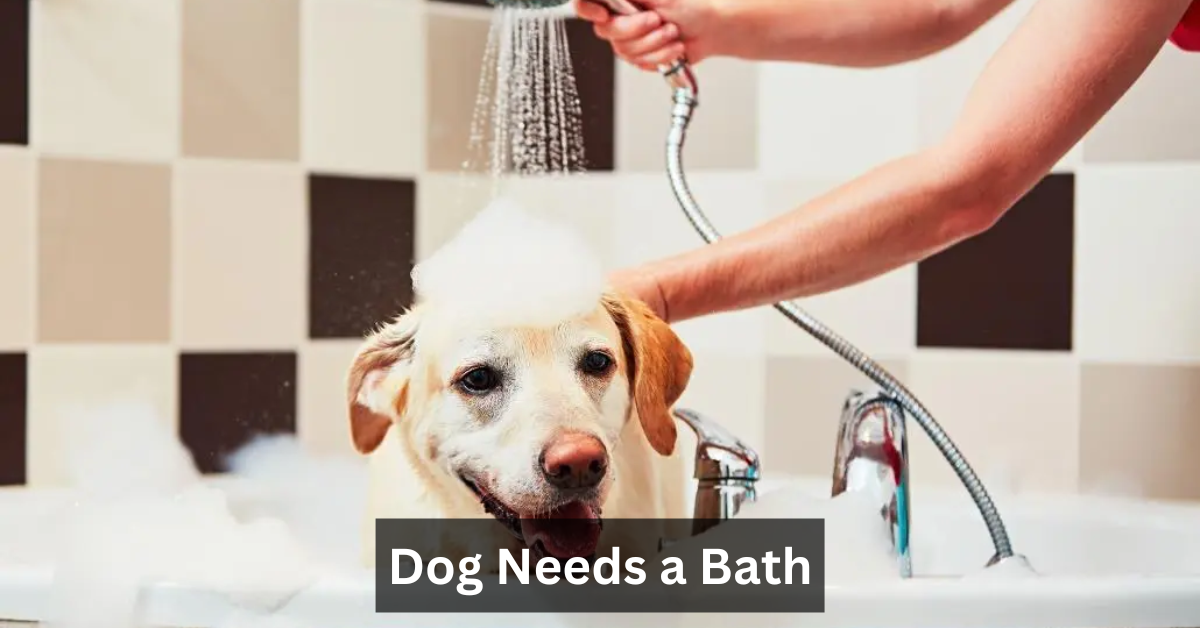Recognizing the Signs Your Dog Needs a Bath is a vital part of keeping your pup healthy, happy, and clean. Bathing is more than just a way to get rid of bad smells or dirt—it’s a proactive approach to dog hygiene that prevents skin issues, reduces allergens, and improves coat quality. A well-bathed dog tends to suffer less from itchy skin, parasites, and excessive shedding. Dogs who aren’t bathed regularly may experience problems such as dermatitis, hot spots, yeast infections, and even behavioral stress caused by physical discomfort.
According to expert recommendations from organizations like the American Kennel Club (AKC) and Canine Dermatologists, bathing your dog at appropriate intervals—sometimes as frequent as every 2 weeks or as sparse as once every 3 months, depending on breed and lifestyle—is critical for long-term wellness. In this guide, we’ll explore the top 15 Signs Your Dog Needs a Bath, give product suggestions like Burt’s Bees or Earthbath, and walk you through a stress-free bathing experience that benefits both dog and owner.
The Top 15 Signs Your Dog Needs a Bath
Understanding the Signs Your Dog Needs a Bath helps you avoid problems before they escalate. Let’s break them down in detail.
Your Dog Has a Persistent Odor
A lingering smell—even after brushing—is a red flag. Persistent odor can indicate the buildup of bacteria, yeast, or grime in your dog’s coat. Dogs who spend time outdoors are particularly vulnerable to picking up smells that require deep cleaning with a product like TropiClean or Earthbath. If your dog still smells after a wash, consult a Veterinarian.
Visible Dirt, Mud, or Grime on the Coat
If your dog returns from the park with caked-on mud, grass stains, or general filth, this is one of the most obvious dirty dog signs. Dogs like Labrador Retrievers or Shih Tzus, which love water and outdoor fun, often return home in need of a scrub-down. Don’t wait—this is one of the loudest Signs Your Dog Needs a Bath.
Excessive Scratching or Licking
Your dog may be trying to relieve discomfort caused by dirt, allergens, or parasites on its skin. Constant licking or scratching can be a sign of skin irritation or the presence of fleas. A bath using hypoallergenic dog shampoo may be your first line of defense.
Greasy or Sticky Fur
A sticky, greasy coat can indicate seborrhea, overactive oil glands, or simply built-up residue from an unwashed coat. This is especially common in breeds with double coats like Golden Retrievers. If your dog’s fur looks like it has a film on it, that’s one of the clearest Signs Your Dog Needs a Bath right away.
Dry, Flaky, or Scaly Skin
Dry skin in dogs is often the result of improper grooming, diet, or weather changes. Bathing your dog with moisturizing or medicated shampoo can significantly relieve symptoms. Dogs that only get bathed once every 3 months may start developing flakes much sooner, especially during dry winter months.
Your Dog Rolled in Something Smelly
Dogs love to roll in the worst things—garbage, poop, and even dead animals. If your dog smells foul or earthy after an outdoor romp, there’s no question here—this is one of the most urgent Signs Your Dog Needs a Bath immediately. Use an odor-neutralizing shampoo and be generous with the rinse.
Dirty Paws and Undercarriage
Even if your dog’s back appears clean, always inspect the belly and paws. These areas can trap dirt, allergens, and even fungal spores, leading to infections if left unchecked. Paw cleaning tips include using grooming wipes after walks, but a full bath is often necessary after dirty outdoor adventures.
Excessive Shedding or Matted Hair
Increased shedding or tangled clumps of fur point to poor coat maintenance. Use a de-shedding tool like a Furminator before bath time to remove loose fur, then apply a conditioning shampoo to help with shedding control and coat softness.
Allergy Symptoms or Skin Sensitivities
If your dog is sneezing, itching, or has red, watery eyes, it might not be seasonal allergies—it could be allergens trapped in the coat. Bathing with an anti-allergen dog shampoo can reduce irritation and improve comfort. This is a less obvious but very important sign your dog needs a bath during allergy season.
Presence of Fleas, Ticks, or Parasites
Fleas and ticks are more than nuisances—they can lead to severe skin conditions in dogs, including rashes and secondary infections. When you spot parasites, a bath with a flea-control shampoo is essential, followed by regular grooming and inspection. Pet stores like PetSmart and Petco offer professional flea bath services.
Dull or Lifeless Coat
A glossy coat is a sign of good health and grooming. A dull, dry-looking coat may signal that oils and dead skin are accumulating. A bath using Burt’s Bees Oatmeal Shampoo can help restore that healthy sheen. Don’t ignore this visual clue—this is one of those cosmetic but telling Signs Your Dog Needs a Bath.
Red or Irritated Skin Patches
Rashes, red patches, and bumps often indicate dog skin irritation or developing infections. While some issues require vet attention, many can be eased by regular baths with medicated or anti-inflammatory shampoos.
Odor Returns Soon After Brushing
Brushing your dog helps, but if odor returns within a few hours or days, a bath is overdue. Brushing alone doesn’t remove sweat, dander, and microbes. This reoccurring smell cycle is a major sign your dog needs a bath.
It’s Been More Than a Month Since Last Bath
Even if your dog looks clean, if it’s been over four weeks, you’re likely past due. For many breeds, bathing once every 3 months is the absolute minimum. The AKC recommends adapting your dog bathing schedule based on breed, activity, and season.
Skin Discoloration or Blackheads
Unusual dark spots or blackheads on the belly or groin area often suggest clogged pores or yeast buildup. These signs demand immediate bathing and possibly a consultation with a Canine Dermatologist.
How Often Should You Bathe Your Dog?
Breed Guidelines and Grooming Frequency
Short-haired breeds like Beagles or Greyhounds can be bathed every 2–3 months, while long-haired breeds like Shih Tzus may require baths every 2–4 weeks. Dogs with skin conditions or allergies may benefit from more frequent bathing—sometimes even weekly, under guidance from a Veterinarian.
Environment and Activity Matter
Dogs that frequent the dog park, hike trails, or swim in lakes need more frequent baths due to exposure to dirt and bacteria. If your dog lives mostly indoors, a bath once every 3 months may suffice—though always monitor for Signs Your Dog Needs a Bath regardless of routine.
Seasonal Considerations
Spring and summer bring pollen, humidity, and parasites. Winter may reduce outdoor time but increases the risk of dry skin. Adjust your dog care routine accordingly, and consider keeping a grooming calendar.
Best Bathing Practices for Healthy Skin and Fur
Pick the Right Shampoo
Choose products based on your dog’s specific needs. For example:
- Burt’s Bees for sensitive skin
- Earthbath for oatmeal conditioning
- TropiClean for odor control
- Medicated shampoos for dermatitis or mange
- Groom First, Then Bathe
Use a slicker brush or Furminator to remove tangles and mats before washing. Wet fur hides mats, which can get worse if not addressed beforehand.
Aftercare and Brushing
Towel-dry thoroughly, especially around ears and paws. Avoid blow dryers unless they’re made for pets, and always brush post-bath to keep the coat smooth and prevent tangles.
When Bathing Isn’t Enough—Time to See the Vet
Persistent Skin Issues
If you notice no improvement after regular bathing or signs of yeast infection, mange, or open wounds, consult a Veterinarian or Canine Dermatologist.
Strange Odors Not Resolved by Bathing
Some smells—like metallic, fishy, or sour—can indicate infections or impacted glands. These are not just Signs Your Dog Needs a Bath, but medical symptoms.
Conclusion
Identifying the Signs Your Dog Needs a Bath is one of the most loving, responsible things you can do as a pet owner. Whether it’s a foul smell, greasy fur, or itchy skin, being aware of these cues can prevent discomfort and serious health problems. Pair the right products with a consistent grooming routine, and you’ll keep your dog clean, comfortable, and full of joy.
Frequently Asked Questions
How often should you bathe your dog?
It depends on breed, coat type, and lifestyle. Anywhere from every 2 weeks to once every 3 months is common.
Is bathing too often harmful?
Yes. Overbathing strips oils, leading to dry skin in dogs and irritation.
Can I use baby shampoo?
No. Human pH levels differ from canine skin. Always use dog-safe products.
What if my dog fears water?
Use calming sprays, treats, and positive reinforcement. You may also consider professional pet grooming services.
Stay in touch to get more updates & alerts on Erome! Thank you



